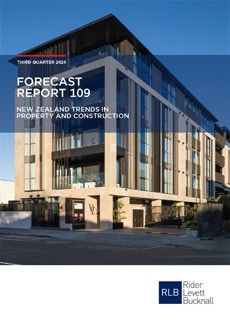According to the Rider Levett Bucknall (RLB) Forecast 109 report – New Zealand Trends in Property and Construction – construction demand outlook remains weak, with signs of stabilisation.
RLB Director Grant Watkins commented, “Cost pressures have reduced in the construction sector, and the weak demand environment is putting downward pressure on prices in the sector. This suggests further easing in construction cost inflation over the coming year.”
He added,“ Stats NZ Building Work Put in Place showed a contraction in construction activity in the first quarter of 2024. Both residential and non-residential construction declined over the quarter as higher interest rates and heightened uncertainty over the economic outlook dampened construction demand. There was a decline in construction activity across the regions.”
Auckland leads construction activity
Forecast 109 noted that Auckland remains the dominant driver of construction activity, making up around 40 per cent of nationwide construction activity (on a nominal basis). This reflects the continued concentration of migration-led population growth in the region.
Meanwhile, Waikato’s share of nationwide construction activity has eased in recent quarters and currently makes up 9 per cent of nationwide construction activity.
Building activity indicators point to continued weakness in the construction pipeline in the near term. Dwelling consent issuance has continued to decline in recent months, with a reduction in demand across all types of dwellings since the beginning of the year. The annual number of dwelling consents issued eased below 35,000 for the year to May 2024.
Government makes plans to improve housing affordability
Grant continued, “In July, the government announced its Going for Housing Growth policy, which included plans to increase the supply of land available for housing development by removing restrictions on minimum floor area for apartments and rules to allow cities to expand outwards at the fringes.”
“Making it easier to build new dwellings is an attempt to increase the housing supply in the market in order to improve housing affordability. The government also introduced housing growth targets for Tier 1 and 2 councils, which would require councils to “live-zone” development capacity to provide at least 30 years of housing demand,” he said.
Recovery in construction demand forecast for late 2025
According to Forecast 109, near-term pipeline of construction work remains weak. Construction activity fell in the March 2024 quarter, reflecting a decline in both residential and non-residential construction.
Looking forward, RLB forecasts strong migration-led population growth and lower interest rates to support a recovery in construction demand later in 2025. An acceleration in the number of New Zealanders leaving the country presents downside risks to the construction outlook.
Nationwide decline in education buildings, health facilities and retail outlets
Forecast 109 noted a sharp decline in consent issuance for education buildings continues to be a key driver of the weakness in non-residential construction demand for the year to May 2024.
There has also been a substantial decline in demand for the construction of health facilities and retail outlets nationwide. The decline in demand for health facilities has followed strong demand in recent years.
Meanwhile, RLB expects demand for new retail outlets will remain weak, given households are reining in discretionary spending in the face of higher mortgage repayments and softening in the labour market. In contrast, there has been an increase in demand for the construction of industrial buildings, driven by strong growth in Auckland. We expect the robust demand for warehouses to ease over the coming year, given the broad-based softening in demand.
Consent issuance falls sharply in Waikato and Canterbury
Over the past year, growth in non-residential consent issuance has been concentrated in Auckland. This was driven by strong demand for the construction of storage and industrial buildings.
There was also growth in non-residential consent issuance in the Bay of Plenty, although to a much smaller degree. This growth was largely driven by increased demand for the construction of office space over the past year.
In contrast, non-residential consent issuance fell sharply in Waikato and Canterbury over the past year. In Waikato, this was driven by reduced demand for storage buildings, while in Canterbury, demand for the construction of education and industrial buildings, as well as health facilities, decreased.
Construction cost inflation eases as labour shortages make a turnaround
Grant concluded, “Non-residential construction cost inflation continued to ease on an annual basis in March 2024 as capacity pressures continued to ease in the construction sector. In particular, there has been a remarkable turnaround in labour shortages in the construction sector.”
“The 0.8 per cent increase in non-residential construction costs over the quarter saw annual non-residential construction cost inflation fall to 4.6 per cent for the year to March 2024. We expect construction cost inflation will continue to ease over the coming years, reflecting the continued easing in capacity pressures in the sector,” he added.
RLB forecasts annual non-residential construction cost inflation to ease to 2.5 per cent in early 2025. Beyond that, we expect a recovery in construction demand will underpin a lift in construction cost inflation from the second half of 2025.
FURTHER INFORMATION:



